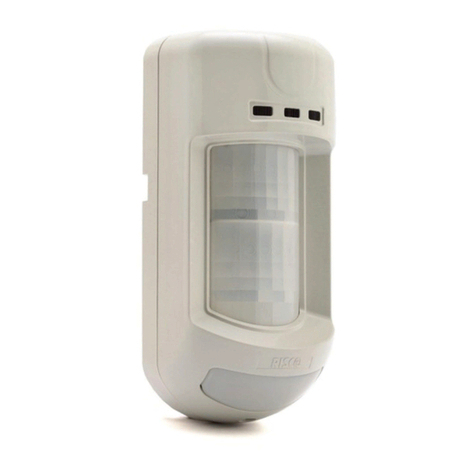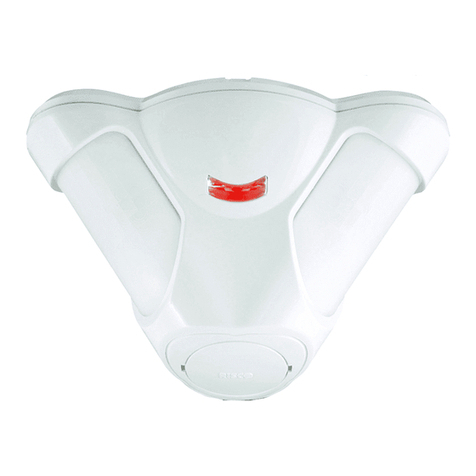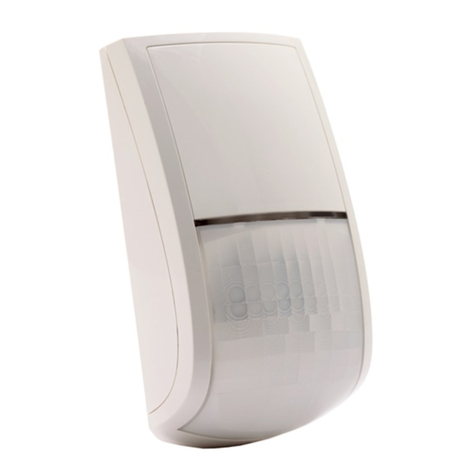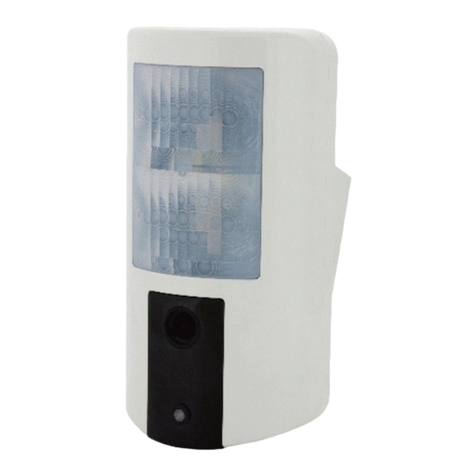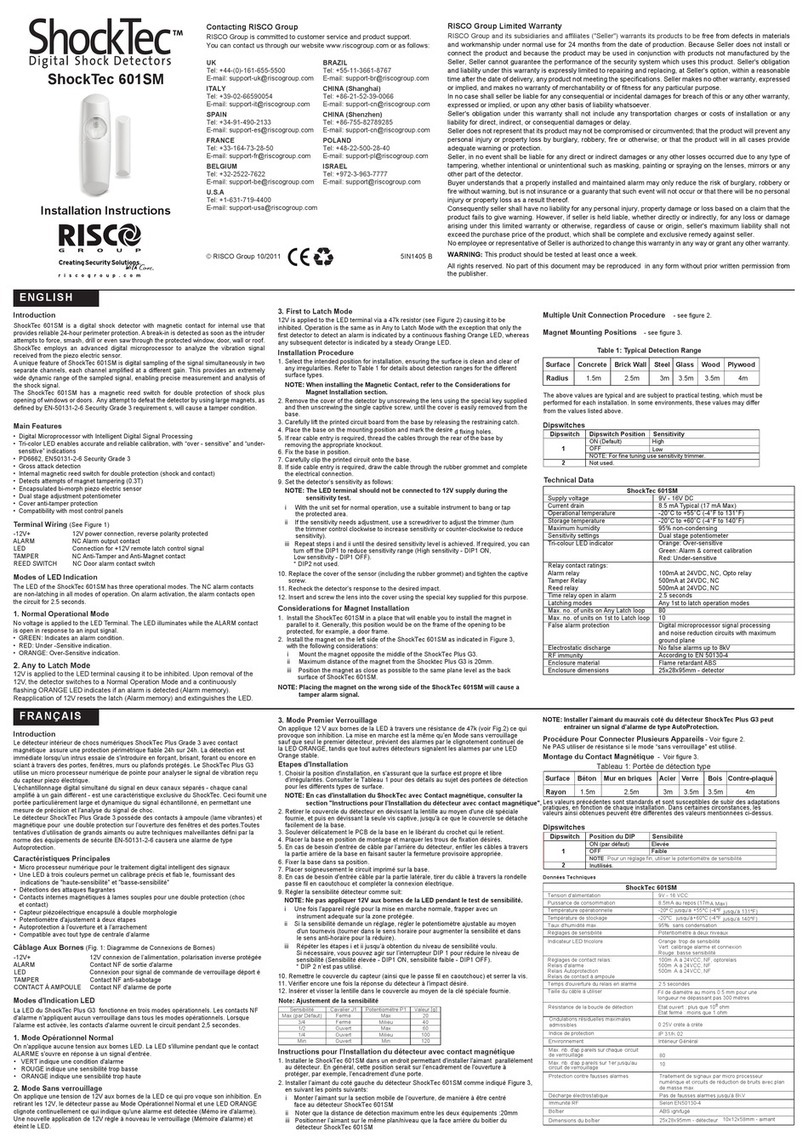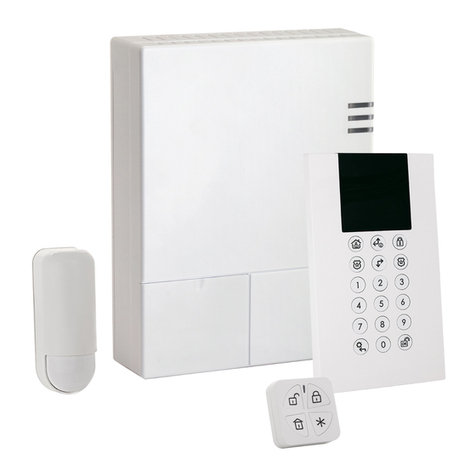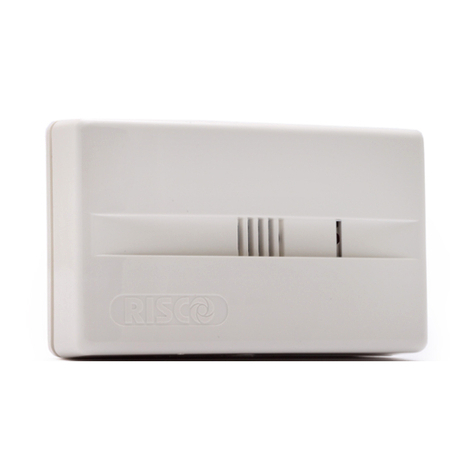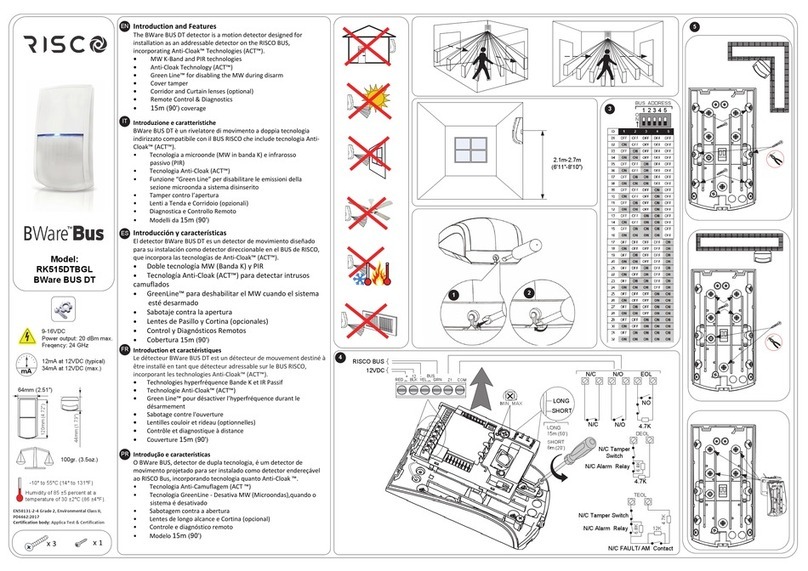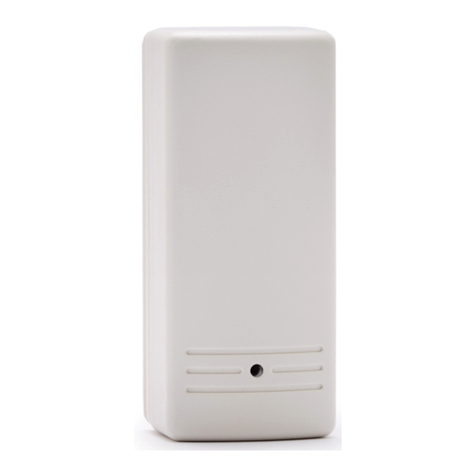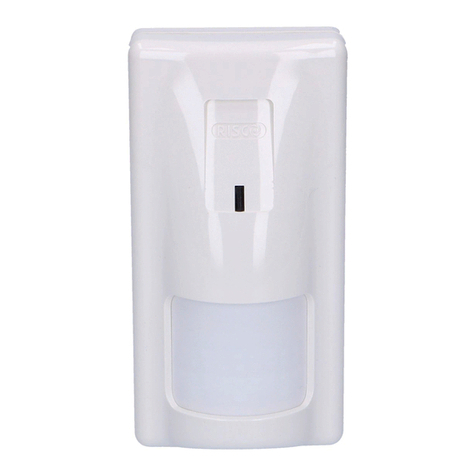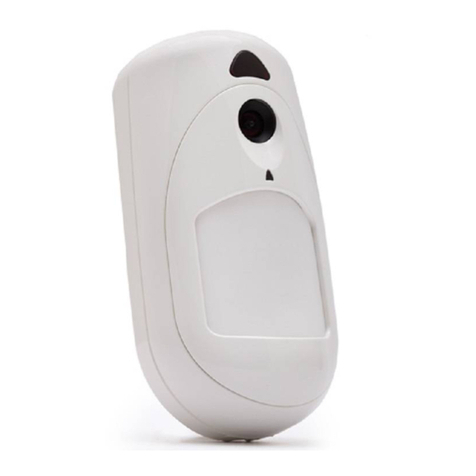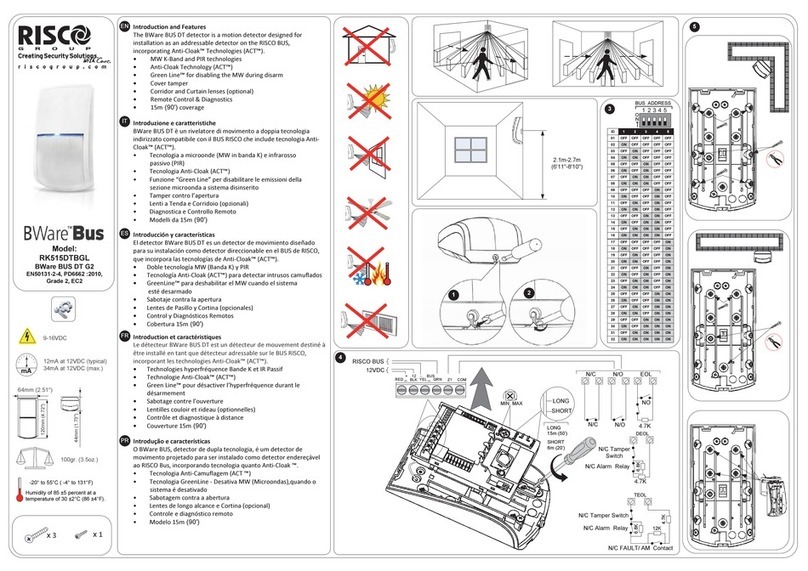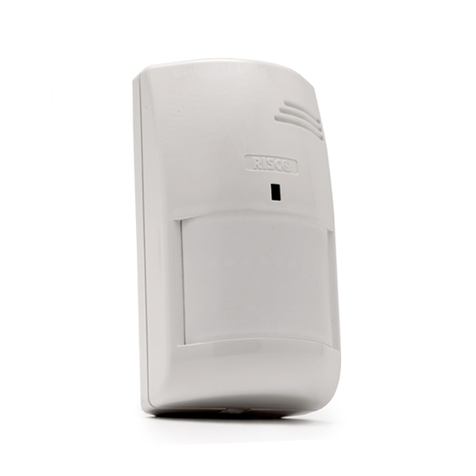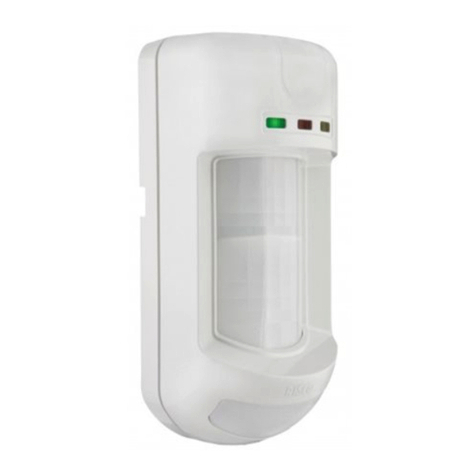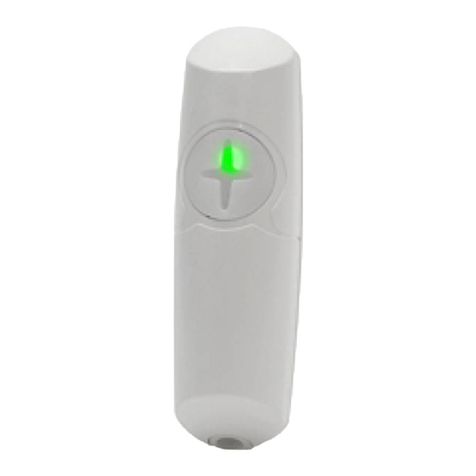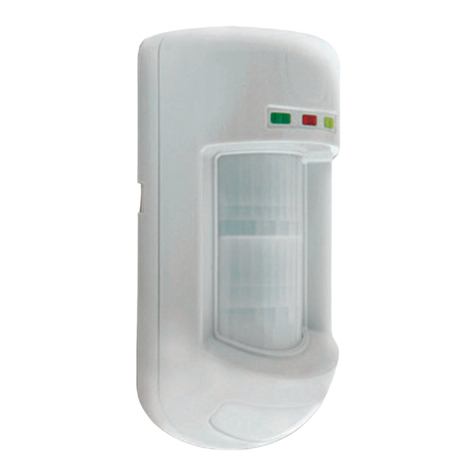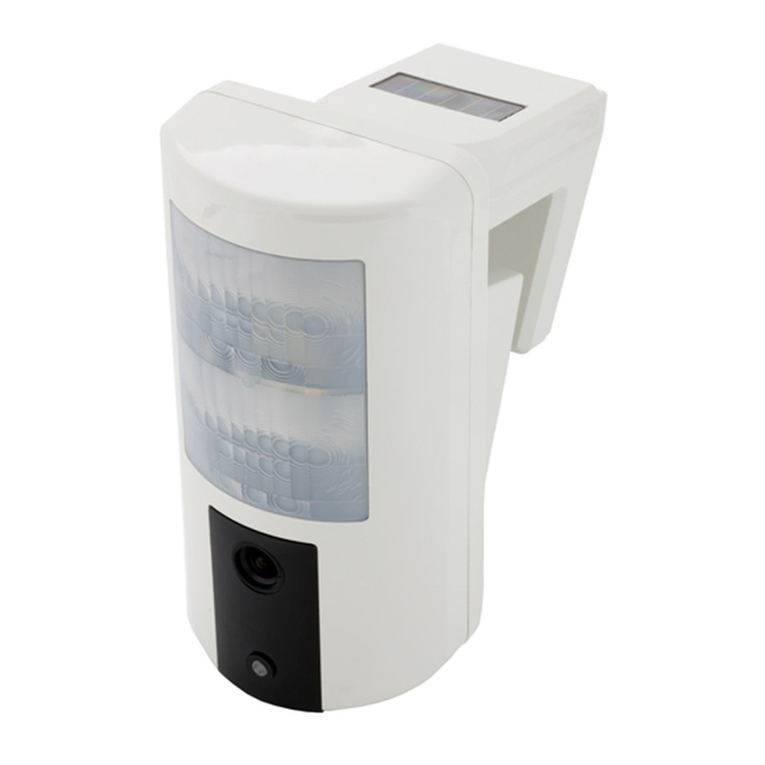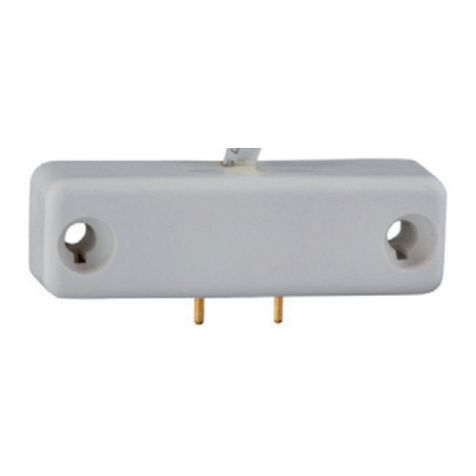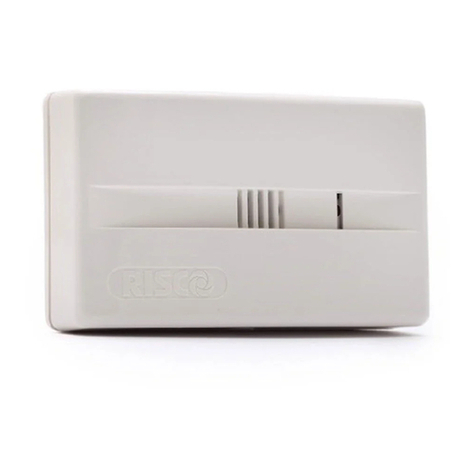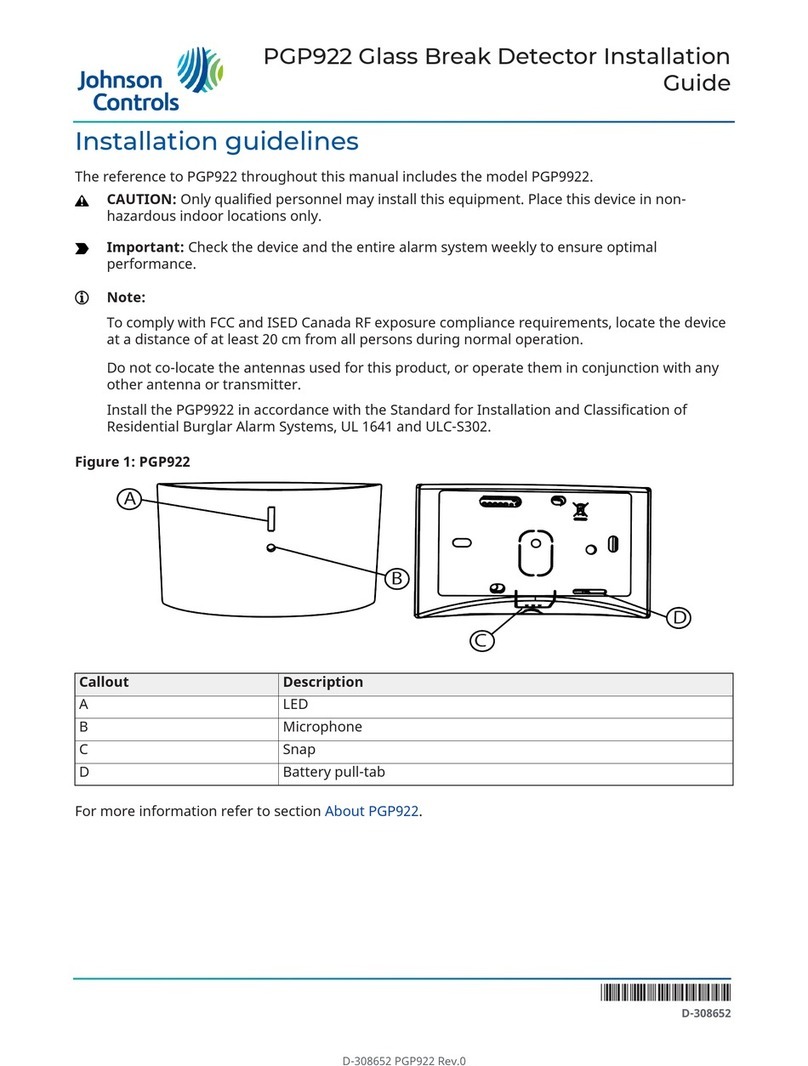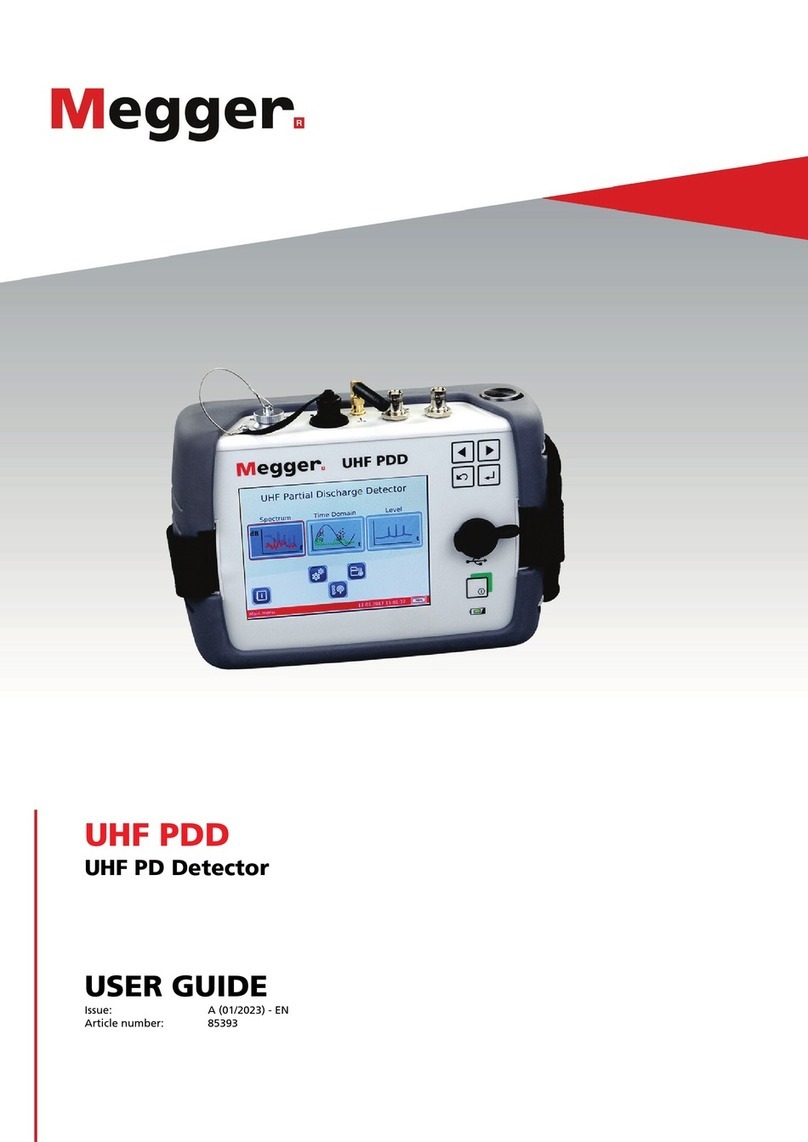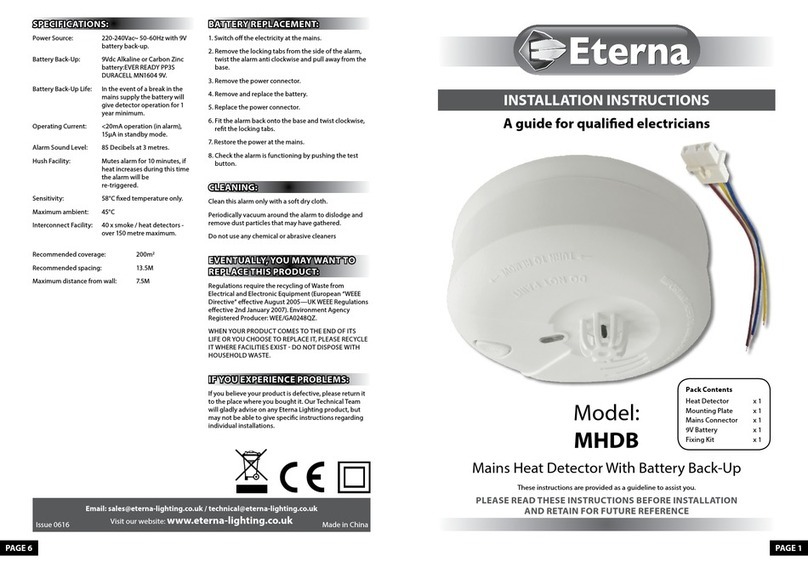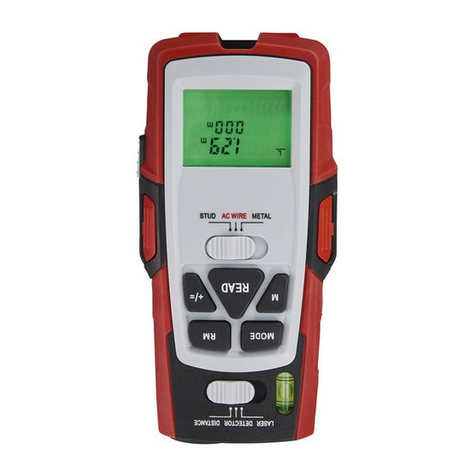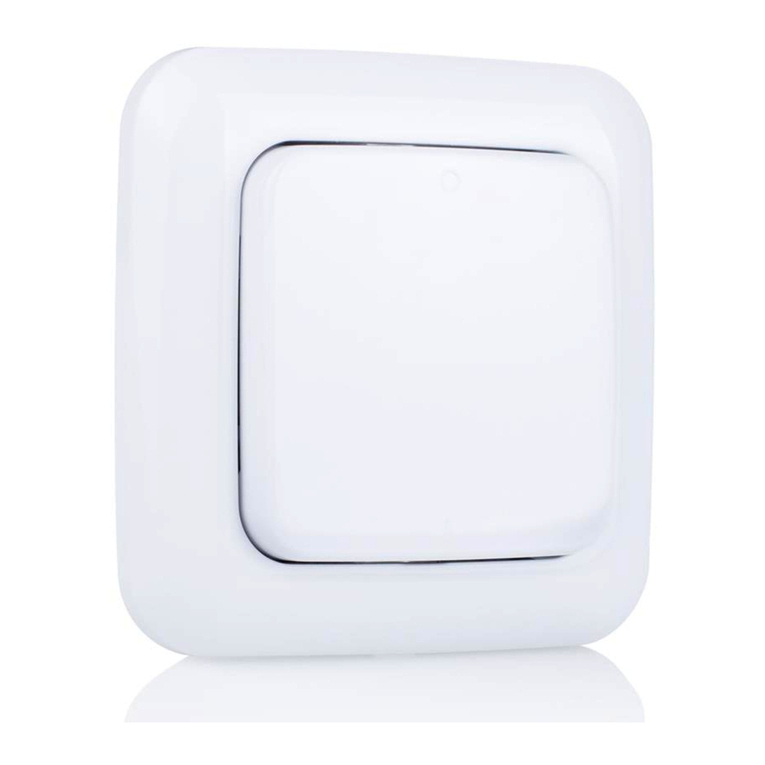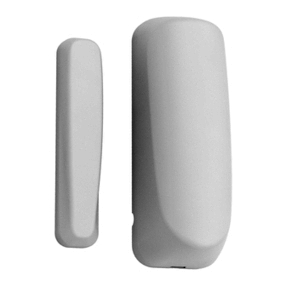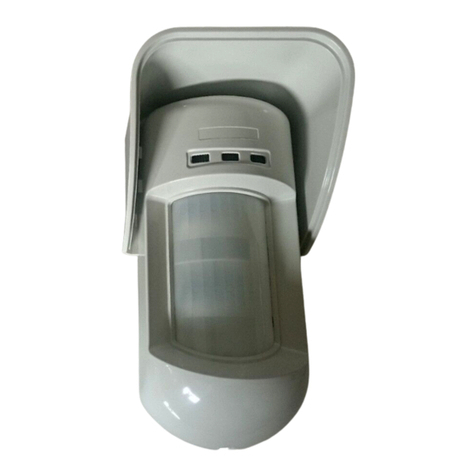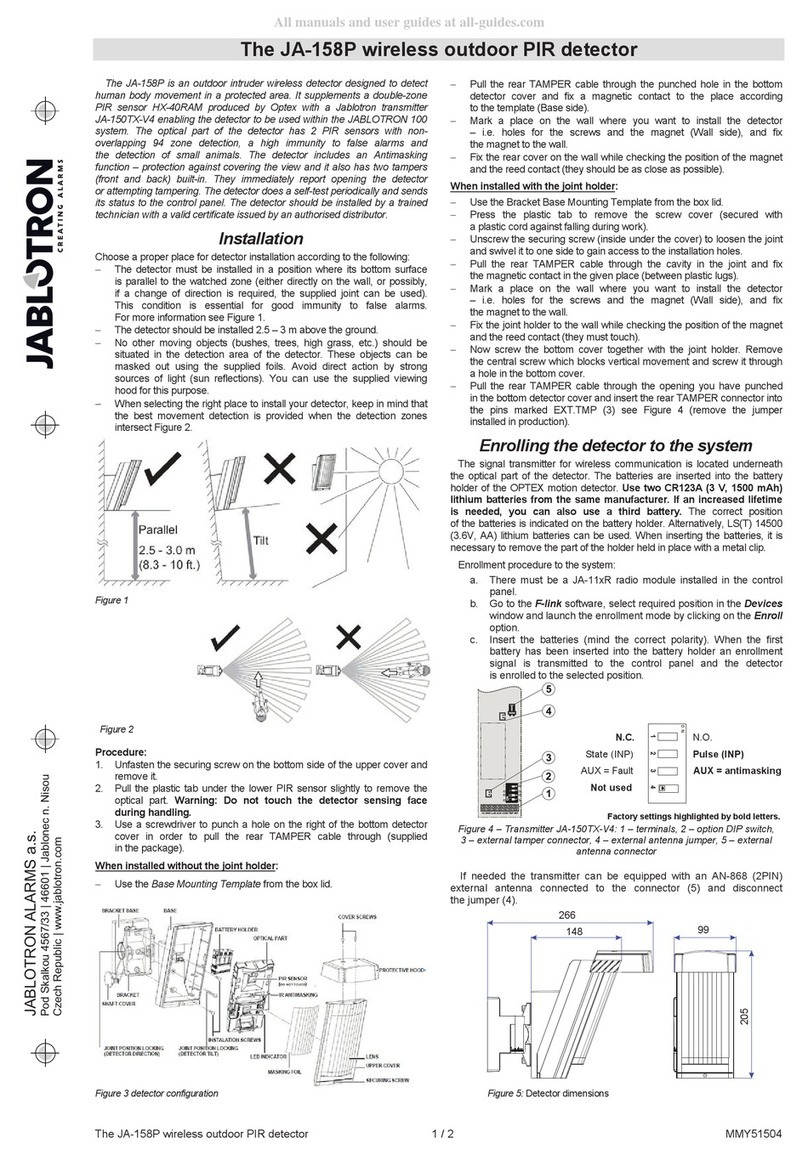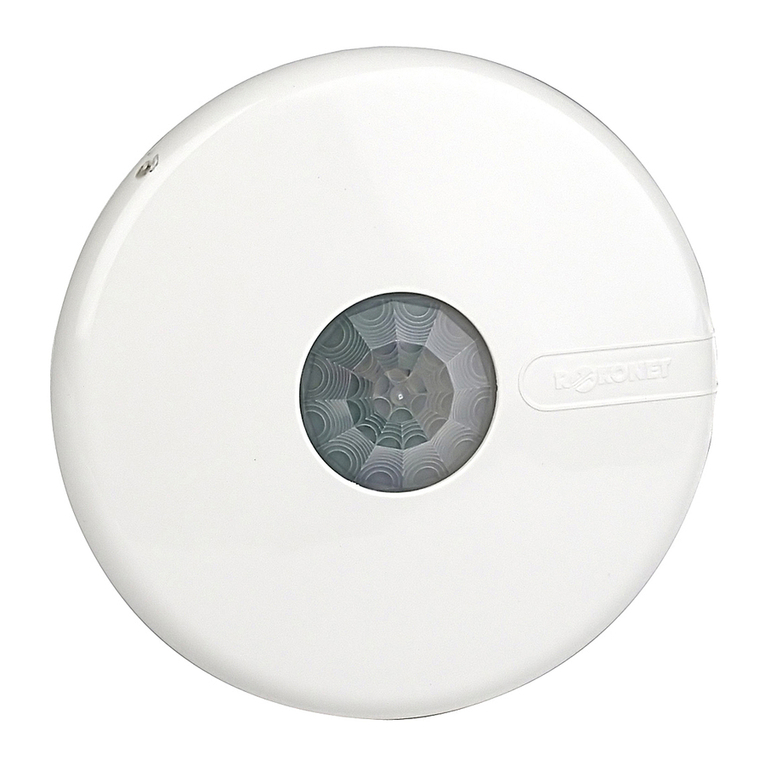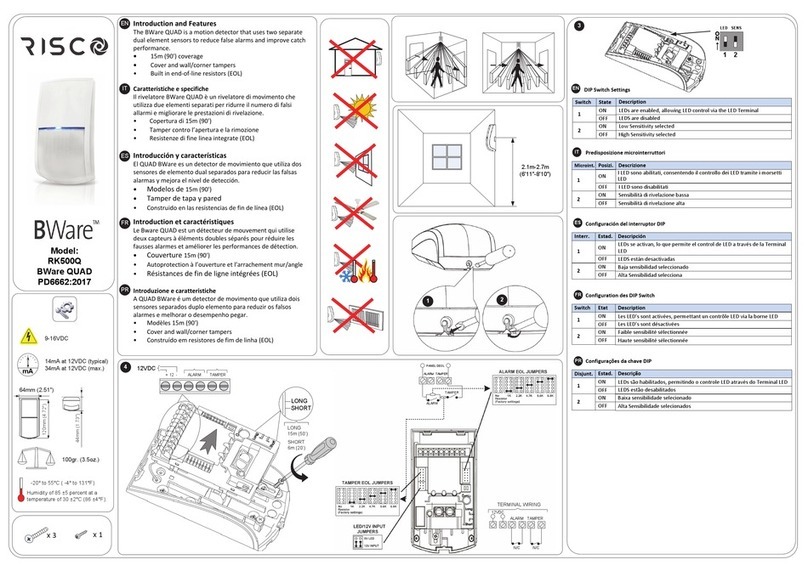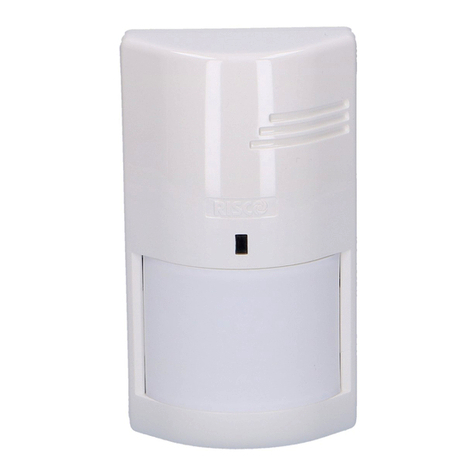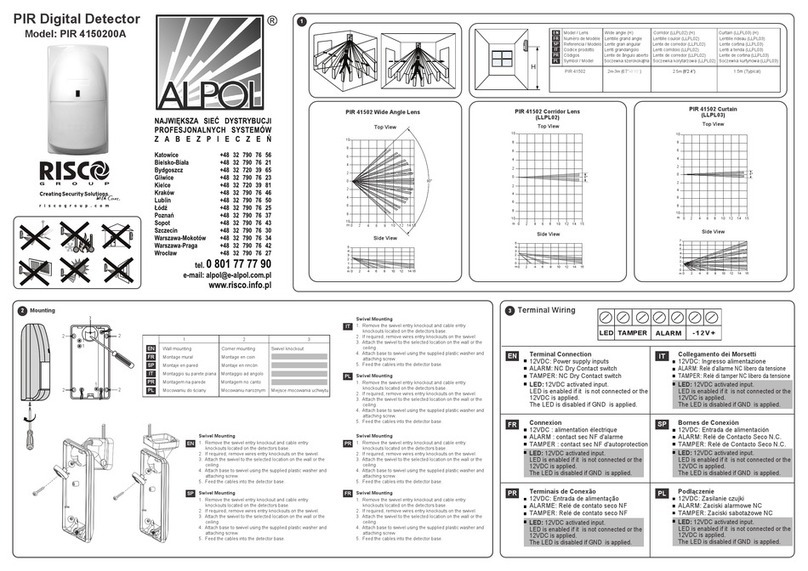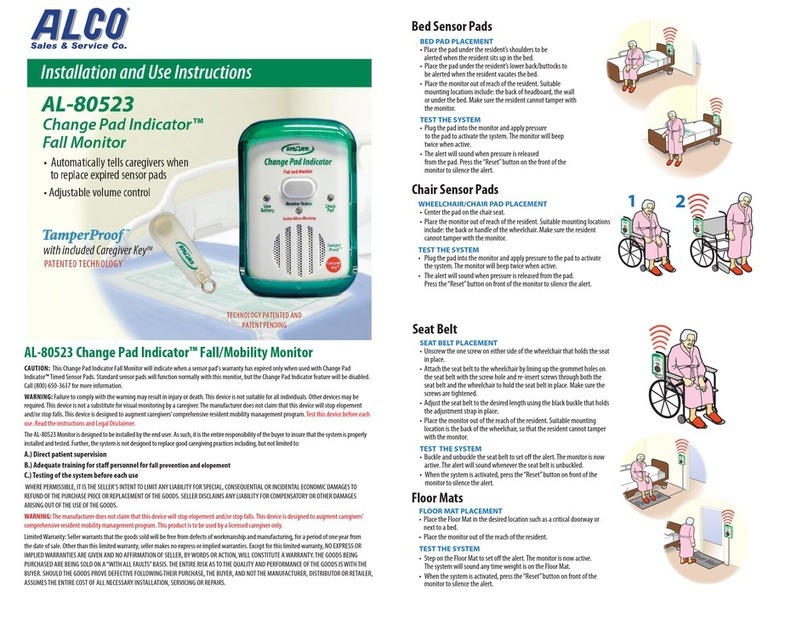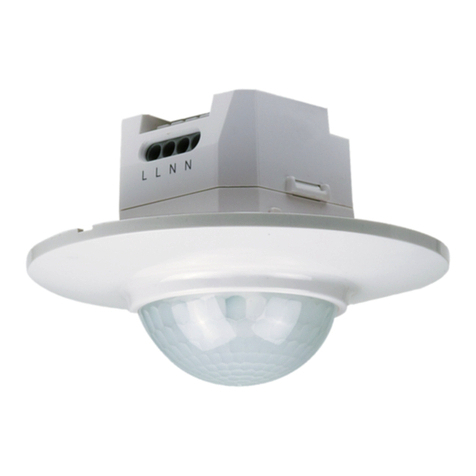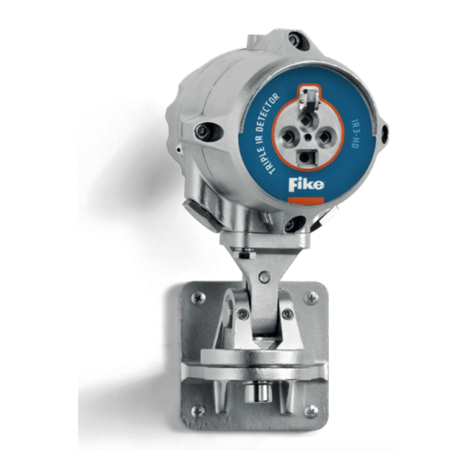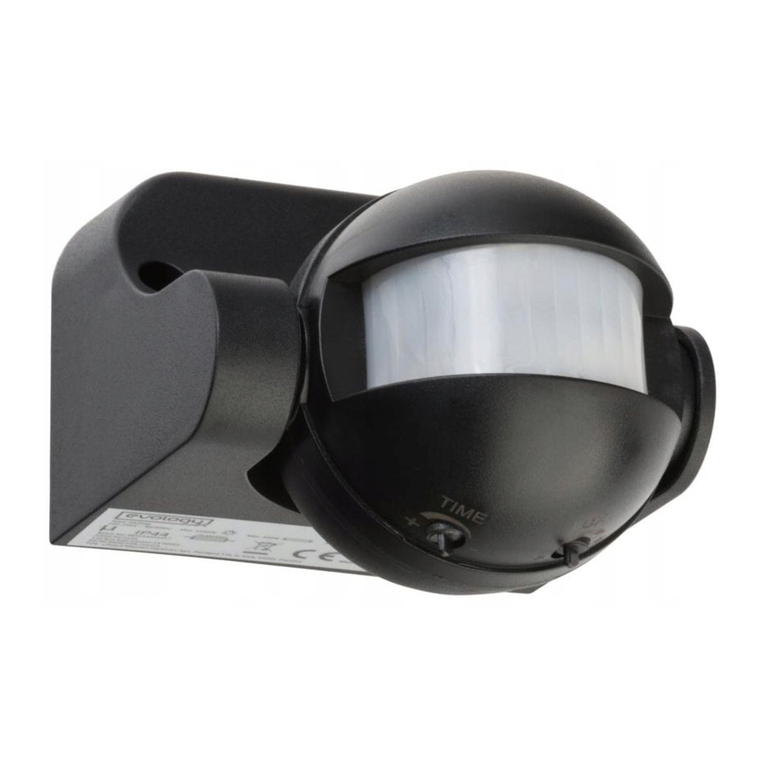
iWISETM
Models:
RK815DTG3/RK815DTG3A
RK825DTG3/RK825DTG3A
Hauteur de montage et position selon la taille de la pièce :
Pour le RK815DTG3/RK815DTG3A
Hauteur de montage L - LONG C - COURT (SHORT)
Pour le RK825DTG3/RK825DTG3A
2.1m-2.7m (6'11"-8’10") 15m (50’) 6m (20’)
1.8m-2.0m (5'11"-6’7") 25m (82’) 8m (26’)
MIN MAX
ENGLISH
RK815DTG3/RK815DTG3A/RK825DTG3/RK825DTG3A detectors are available in 15m
and 25m models, and include built-in end-of-line (EOL) resistors to simplify installation.
Installation / Maintenance
1. Mounting - The iWISE
RK815DTG3/RK815DTG3A/RK825DTG3/RK825DTG3A
can be mounted
either on a flat surface or on a wall corner (corner mounting).
•Using a suitable tool, open the following knockouts on the detector’s base (see Figure 1).
Note: If a back tamper is to be used it is mandatory to screw the tamper back plate to the wall (or
wall corner).
2. To select the correct vertical adjustment position for wide angle lens, use the scale on the bottom
left hand side of the PCB as follows:
Mounting height and scale position based on room size:
For RK815DTG3/RK815DTG3A
Mounting Height L - LONG S - SHORT
2.1m-2.7m (6'11"-8’10") 15m (50’) 6m (20’)
For RK825DTG3/RK825DTG3A
1.8m-2.0m (5'11"-6’7") 25m (82’) 8m (26’)
Note: For Corridor installations, select position to 'LONG' and mount the detector at 2.5m/8’2” height.
3. Set jumpers (see Jumper Setting section).
IMPORTANT: On the face of the Microwave, you will find a colored dot, this represents the Microwave
channel. When installing two detectors in near locations, it is recommended that these dots (channels)
are not of the same color. Example: Two Red should be avoided
Note: Reset the detector after each change made to the settings.
4. Install the front cover back to its place (in a reverse sequence of the removal.
5. Perform a Walk test (see Walk Test section).
6.
Changing Lenses (see Figure 2).
Terminal Wiring (see Figure 5)
Terminal Description
- 12 + 12VDC Input
ALARM N.C. Relay
TAMPER N.C. Tamper switch
FAULT/AM Normally Closed Relay: The FAULT/AM relay opens in the following events:
• Detector is masked (Alarm relay is also opened)
• Self test failed
• Input voltage is lower than 8VDC
LED LED operation remote control
When an ”Activation Signal”** is applied to the LED input terminal, all LEDs will
be disabled.
LEDs are enabled if nothing is connected (unless LED jumper is OFF) or 0V/12V
is applied (according to the LED/SET Input Jumper position, 12V or 0V).
SET Remote SET/UNSET control
SET:If an ”Activation Signal”** is applied, anti-mask detection is disabled (for
Grade 2 configuration).
UNSET: If nothing is connected or 0V/12V is applied (according to the LED/SET
Input Jumper position, 12V or 0V) anti-mask detection is enabled (see also
“Green Line” and “Remote Self Test”
**Activation Signal-
If 12VDC is applied, and the LED/SET Input Jumper is on 12v position
- Or -
0V is applied and LED/SET Input Jumper is on 0V position
Jumper Settings
Jumper Function
SW1-2: ACT
ON
ACT Enabled
Important: Do not use ACT™ mode if you are expecting that there will be
moving objects outside the required protected area, a corridor for example.
OFF ACT Disabled.
SW1-1: LED Used to determine the operation of the detector’s LEDs
Used to determine if ACT mode is enabled or disabled
ON: LEDs are enabled, allowing LED control via the LED input terminal
OFF: LEDs are disabled
Walk Test
1. Two minutes after applying power (warm-up period), walk test the Detector over the entire protected
area to verify proper operation of the unit (see Figure 6).
2. The MW range can be adjusted by using the potentiometer located on the PCB. It is important to set
the potentiometer to the lowest possible setting that will still provide enough coverage for the inner
boundary protected area (see Figure 4).
MW range adjustment (Figure 4)
1 Over power A Detector
2 Under power B Corridor
3 Correct adjustment
Red On ALARM
Flashing Fault / Anti-Masking detection
Note: Anti Masking detection is operational in “Unset” mode only
(see Terminal Wiring section, SET terminal).
All LEDs Flashing At power-up, the LEDs will flash consecutively until the end of the
warm-up period (2-3 minutes). At the end of the warm-up period
the RED LED will continue to flash until the end of AM initiation.
(consecutively)
LEDs Display
LED State Description
Yellow On PIR detection
Flashing Trouble in PIR channel
Green On MW detection
Flashing Trouble in MW channel
Note: AM and Trouble indications continue until masking is removed or trouble is corrected.
Technical Specification
Electrical
Current consumption 16.8mA at 12VDC (Typical)
39.5mA at 12VDC (max.)
Voltage requirements 9 -16VDC***
Alarm contacts 24VDC, 0.1A
Tamper contacts 24VDC, 0.1A
FAULT/AM contacts 24VDC, 0.1A
Environmental
RF immunity According to EN50130-4
Operating temperature -10C to 55C (14F to 131F)
Storage temperature -20C to 60C (-4F to 140F)
Optical
Filtering White Light Protection
Physical
Size 127.6 x 64.2 x 46.6 mm (5 x 2.5 x 1.84 in.)
Weight
*** Power to be supplied by 5A max. power source using safety approved wires,
with a min Gauge of 20AWG.
120 gr. (4.2 oz.)
FRANÇAIS
Les détecteurs RK815DTG3/RK825DTG3 sont les tout derniers modèles de détecteurs de mouvement
conçus pour les établissements professionnels. Ils intègrent deux technologies de pointe: Anti-masque
et Anti-Cloak™ (ACT™) Anti-camouflage, qui répondent aux nouvelles directives de protection de
l'environnement. .
Disponibles en modèles 15m et 25m, les détecteurs RK815DTG3/RK825DTG3 comprennent des
résistances de Fin de ligne (EOL = end-of-line) intégrées qui facilitent l'installation.
Installation
1. Montage – RK815DTG3/RK825DTG3 peut être installé soit sur une surface plane soit en coin
(gauche ou droit).
•
A l’aide d’un outil adequat, ouvrez les pastilles pr
é-
perc
ée
s correspondantes sur la báse du d
tecteur (cf. Figure 1).
Remarque: En cas d'utilisation d'une autoprotection arrière, il est impératif de fixer la plaque de cette
dernière en la vissant au mur (ou à l'angle du mur).
2. Pour définir le bon réglage vertical, positionnez l'appareil en LENTILLE GRAND ANGLE. Servez-vous
de l'échelle figurant sur le côté inférieur gauche de la carte PCB (cf. Figure 6) comme suit :
3. Réglez les cavaliers (cf. § Réglage des cavaliers).
Remarque: Il est conseillé de réinitialiser le détecteur après chaque modification apportée au réglage.
4. Replacez le couvercle frontal (en inversant pour cela l'ordre des étapes de la procédure de retrait).
5. Exécutez un test de passage (cf. §Test de passage).
6. Changement des lentilles (cf. Figure 2).
Câblage des Terminaux (cf. Figure 5)
Terminal Description
- 12 + Entrée 12VCC
ALARM Relais N.F., 24VCC, 0,1A
TAMPER Relais N.F., 24VCC, 0,1A
FAULT / AM Sortie normalement fermée : La sortie FAULT/AM s'ouvre dans les cas
suivants :
• Détection ou neutralisation d'un masquage,
• Echec du test automatique,
• Tension d'entrée inférieure à 8VCC.
LED Contrôle à distance des indicateurs LED
Lorsqu'un ”Signal d'Activation”** est appliqué à l'entrée LED du bloc des
terminaux ou bornes de connexion, les indicateurs LED se désactivent
(cf. aussi l'entrée Test automatique dans le tableau consacré au Réglage
des cavaliers).
Les voyants LED sont activés si rien n'est relié (sauf si le cavalier LED
est éteint (OFF).
SET Contrôle à distance de la mise en Service (SET) / mise en Inactivité du
système (UNSET).
SET (mise en service): Si un ”Signal d'Activation”** est appliqué, la
détection de masquage est désactivé (en configuration de catégorie 2).
UNSET (mise en inactivité) : Si aucune connexion n'est appliquée ou
que la Terre (GND/12V) est reliée (selon la position du Cavalier d'entrée
LED/SET, à 12V ou 0V), la détection de masquage est activée (cf.
également les entrées “Green Line” et “Test automatique à distance”
dans le tableau consacré au Réglage des cavaliers).
**Signal d'Activation-
Si une tension de 12VCC est appliquée et que le Cavalier d'entrée LED/SET est en position 12V
-Ou-
Si la Terre (GND) est reliée, le Cavalier d'entrée LED/SET est en position 0V.
Réglage des cavaliers
Cavalier Fonction
SW1-1: LED Définit le fonctionnement des indicateurs LED du détecteur.
Marche (ON) L'activation des indicateurs LED dépend du paramétrage du contrôle à distance
de leur fonctionnement (cf. § Câblage des Terminaux, borne de connexion LED).
SW1-4: Self
Test Used to test detection technologies.
(Local Self Test): If there is no alarm detection in the PIR channel for a period
of one 1 hour, the detector will self-test. If the local self test fails, the FAULT/A
M
Relay will activate.
ON
Arrêt (OFF) Les indicateurs LED sont désactivés.
Définit si le mode ACT est activé ou non
SW1-4:
Test
automatique
Permet de tester la capacité de détection des canaux IRP et HF.
(Test automatique local): si aucune détection n'est décelée pendant une période
d'une heure, le détecteur exécute un test automatique. En cas d'échec du test
automatique local, le relais FAULT/AM est activé.
SW1-3: Green Line
RK815DTG3/RK815DTG3A/RK825DTG3/RK825DTG3A, concept qui permet aux détecteurs
de respecter les directives environnementales en évitant les émissions excessives.
Cette caractéristique permet en effet de désactiver le canal HF (hyperfréquence) lorsque
le système d'alarme est inactivé (“UNSET”), neutralisant ainsi tout excès d’émission
d’hyperfréquences’ pendant que les locaux sont occupés.
Marche (ON)
"Green Line" activée: Pour désactiver le module HF pendant les périodes
d'inactivité du système (UNSET), les indicateurs LED doivent aussi être
désactivés à distance.
Arrêt (OFF) Green Line désactivé (OFF): le canal HF est constamment activé.
SW1-2: ACT
Marche (ON) ACT activé.
Important ! N'utilisez pas le mode ACT™ dans une zone en dehors de laquelle
le passage d'objets en mouvement vous paraît logique et attendu, un couloir par
exemple.
Arrêt (OFF)
(Défaut) ACT désactivé.
(Défaut)
(Défaut)
(Default)
(Default)
(Default)
Marche (ON)
SW1-3: Green Line
The RK815DTG3/RK815DTG3A/RK825DTG3/RK825DTG3A includes a Green Line feature
that follows environmental guidelines by avoiding surplus emission. This feature disables the
MW channel when the alarm system is “Unset”, thus eliminating surplus MW emission
while the premises is occupied.
ON Green Line feature is enabled: To deactivate the MW module in “UNSET”
period, the LEDs must also be remotely disabled by the LED terminal.
Note: When ‘Green Line’ is on (Microwave off), the detector will still activate
(PIR only)
OFF Green Line feature in disabled: MW is constantly in use.
(Remote Self Test): Remote Self Test is activated when the SET terminal is
switched from SET to UNSET mode. For remote self test pass, the Alarm Relay
will activate for 5 seconds.
If the remote self test fails, the FAULT/A
M Relay
will activate.
OFF
(Default)
J4 - LED/SET
INPUT Used to determine the polarity of the external input.
See Terminal Wiring section, LED and SET Terminals
See Terminal Wiring section, LED and SET Terminals
J1 - Alarm EOL
J2 - Tamper EOL
J3 - FAULT/AM EOL
Jumpers J1 and J2 allow the selection of Tamper and Alarm resistance
(1K, 2.2K, 4.7K, 5.6K, 6.8K) according to the control panel (see Figure 3) .
Jumper J3 allows the selection of 12K for Fault/Anti-Mask.
Follow the terminal block connection diagram in Figure 3 when
connecting the detector to a Double/Triple End Of Line (DEOL/TEOL)
Zone.
Important: After applying power to the detector, close the cover within 2 minutes as after this
period AM initialization will start.
Remarque: Pour les installations en couloir, sélectionnez la position 'LONG' et appliquez l'option de
montage à hauteur de 2,5m/8’2”.
Les cavaliers J1, J2 et J3 permettent de sélectionner les résistances EOL
(fin de ligne) d'Autoprotection, Alarme et FAULT/AM (1K, 2,2K, 4,7K, 5,6K,
6,8K et 12K) en fonction de la centrale (cf. Figure 3 ci-dessous).
Suivez les indications du diagramme de connexion du bloc des terminaux
de la Figure 3 pour relier le détecteur à une zone EOL Double/Triple
(DEOL/TEOL).
Cavaliers TEOL
J1 - Alarm EOL
J2 - Tamper EOL
J3 - FAULT / AM EOL
Installatie / Onderhoud
1. Montage - De RK815DTG3/RK825DTG3 kan op een vlakke oppervlakte worden gemonteerd, of op
een muurhoek (hoekmontage)
• Met een passend gereedschap opent u de volgende uitwerpers op de basis van de detector (zie
Afbeelding 1).
Opmerking: Als een achterstamper wordt gebruikt, is het verplicht om de achterplaat van de stamper
op de muur (of muurhoek) vast te schroeven
2. Om voor de brede hoeklens de juiste verticale afstelpositie te selecteren, gebruikt u de schaal op de
linker onderkant van de PCB. U doet dit als volgt:
Montagehoogte en schaalpositie op basis van kamergrootte:
Voor RK815DTG3/RK815DTG3A
Montagehoogte L - LANG C - KORT
2.1m-2.7m 15m 6m
Voor RK825DTG3/RK825DTG3A
1.8m-2.0m 25m 8m
Opmerking: Voor installaties in een hal selecteert u de positie naar 'LANG' en monteert u de detector
op een hoogte van 2,5 m/8'2".
3. Jumpers instellen (zie sectie Jumperinstellingen).
Opmerking: Stel na elke wijziging aan de instellingen, de detector opnieuw in.
4. Installeer het voorste lid terug op zijn plaats (in omgekeerde volgorde van de verwijdering).
5. Voer een looptest uit (zie sectie Looptest).
6. Lenzen wisselen (zie. Afbeelding 2).
Bedrading terminal (zie Afbeelding 5)
Terminal Beschrijving
- 12 + 12 VDC-ingang
ALARME N.C.-relais
TAMPER N.C. Sabotageschakelaar
FAULT/AM Normaal gesloten relais: De relais STORING/AM wordt bij de volgende
gebeurtenissen geopend:
• Detectorbewaking wordt ingeschakeld (Relais alarm wordt ook geopend)
• Zelf-test is mislukt
• Ingangspanning is lager dan 8VDC
LED LED-werking afstandsbediening
Als op de LED van de ingangterminal een "Activeringsignaal"** wordt toegepast,
worden alle LED's uitgeschakeld. LED's worden ingeschakeld als niks is
aangesloten (tenzij LED-jumper op UIT is ingesteld) of 0V/12V wordt toegepast
(volgens de LED/INSTELLING positie van de ingangjumper, 12 V of 0 V).
SET Externe besturing INSTELLEN/NIET INSTELLEN
INSTELLEN: als een "activeringsignaal"** wordt toegepast, wordt de anti-
maskeringdetectie uitgeschakeld (voor configuratie Klasse 2).
NIET INSTELLEN: Als niks is aangesloten of als 0 V/12 V wordt toegepast
(volgens de LED/INSTELLING
Als 12 VDC wordt toegepast en de ingangjumper LED/INSTELLEN is op de positie 12V
-Of-
0 V wordt toegepast en ingangjumper LED/INSTELLEN is op positie 0 V
**Activeringsignaal-
Jumperinstellingen
Jumper Functie
SW1-2: ACT Gebruikt om vast te stellen of de ACT-modus is in- of uitgeschakeld.
AAN ACT ingeschakeld
Belangrijk: Niet de ACT™-modus gebruiken als u verwacht dat er buiten het
beschermde gebied (zoals bijvoorbeeld een hal, bewegende objecten zijn.
UIT ACT uitgeschakeld.
(Standaard)
(Standaard)
SW1-1: LED Gebruikt om de werking van de LED's van de detector vast te stellen.
AAN LED's worden ingeschakeld zodat via de ingangsterminal van de LED,
LED-besturing mogelijk is.
UIT LED's worden uitgeschakeld
SW1-4: Zelf
Test Gebruikt om detectietechnologieën te testen.
(Lokale zelftest): als in het PIR-kanaal gedurende 1 uur geen alarmdetectie
plaatsvindt, voert de detector een zelftest uit. Als de lokale zelftest mislukt,
wordt de STORING/AM-relais actief.
(Externe zelftest): de externe zelftest wordt geactiveerd als de terminal
INSTELLEN van de modus INSTELLEN naar NIET INSTELLEN schakelt.
Opdat de externe zelftest slaagt, zal de alarm-relais gedurende 5 seconden
actief zijn. Als de externe zelftest mislukt, wordt de STORING/AM-relais actief.
SW1-3: Groene lijn
De
RK815DTG3/RK815DTG3A/RK825DTG3/RK825DTG3A
bevat de functie Groene lijn
die milieurichtlijnen volgt door een overschot uitstraling te vermijden. Deze functie schakelt het
MW-kanaal uit als het alarmsysteem op "Niet instellen" is ingesteld en dus de overmatige
MW-uitstraling wordt verwijderd terwijl het gebied bezet is.
AAN
Functie Groene lijn is ingeschakeld: om de MW-module in de periode "NIET
INSTELLEN" te deactiveren, moeten ook de LED's van een afstand door de
LED-terminal worden uitgeschakeld.
Opmerking: Als 'Groene lijn' aan is (microgolf uit), is de detector nog steeds
actief (alleen PIR).
UIT
AAN
UIT
Functie Groene lijn is uitgeschakeld: MW is constant in gebruik.
Jumpers J1 en J2 maken de selectie mogelijk voor sabotage- en
alarmweerstand (1K, 2.2K, 4.7K, 5.6K, 6.8K) volgens het bedieningspaneel
(zie Afbeelding 3). Met jumper J3 is de selectie mogelijk van 12K voor
Storing/Anti-maskering.
Volg het aansluitingsschema van het aansluitblok in Afbeelding 3 als u de
detector op een twee-/drievoudige zone aan het einde van de lijn
(DEOL/TEOL) aansluit.
(Standaard)
(Standaard)
J1 - Alarm EOL
J2 - Sabotage EOL
J3 - STORING/
AM EOL
Looptest
Belangrijk: Na voeding naar de detector toe te passen, sluit u het lid binnen 2 minuten. Na deze
periode start namelijk de AM-initialisatie.
1. Twee minuten na het toepassen van voeding (opwarmingsperiode), voert u over het hele beschermde
gebied van de detector de looptest uit om goede werking van de eenheid te verifiëren (zie Afbeelding 6).
2. Het MW-bereik kan worden afgesteld door de potentiometer op de PCB te gebruiken. Het is belangrijk
dat de potentiometer op de laagst mogelijke instelling wordt ingesteld om het binnenste beschermde
grensgebied voldoende dekking te bieden (zie Afbeelding 4).
Jumper Functie
J4 - LED/
INSTELLEN
INGANG
Gebruikt om de polariteit van de externe ingang vast te stellen.
Zie de sectie Bedrading terminal, terminals LED en INSTELLEN
Zie de sectie Bedrading terminal, terminals LED en INSTELLEN
MIN MAX
Afstelling MW-bereik (zie Afbeelding 4)
1 Overspanning
2 Onderspanning
3 Juiste afstelling
A Detector
B Hal
Groen Aan MW-detectie
Knipperen Storing in MW-kanaal
Rood Aan ALARM
Knipperen Storings-/anti-maskeringsdetectie
Opmerking: Anti-maskeringsdetectie is alleen in de
modus "Niet instellen" werkzaam (zie sectie Bedrading
terminal, terminal INSTELLEN).
Alle LED's Knipperen Opwarmingsperiode (2-3 minuten). Aan het einde
van de opwarmingsperiode gaat de RODE LED door
met knipperen tot het einde van de AM-initiatie.
(achtereenvolgende)
Opmerking: AM- en Storingsindicaties gaan door totdat de maskering wordt verwijderd of de
storing wordt gecorrigeerd.
Technische specificaties
Elektrisch
Stroomverbruik 16.8mA bij 12VDC (typisch)
39.5mA bij 12VDC (max.)
Spanningsvereisten 9 -16VDC
Alarmcontacten 24VDC, 0,1A
Sabotagecontactencontacten 24VDC, 0,1A
STORING/AM-contacten 24VDC, 0,1A
Omgeving
RF-immuniteit Volgens EN50130-4
Bedrijfstemperatuur -10C tot 55C
Opslagtemperatuur -20C tot 60C
Optisch
Filtrering Wit licht-bescherming
Fysiek
Grootte 127,6 x 64,2 x 46,6 mm
Gewicht 120 gr.
Display LED's
LED Status Beschrijving
Geel Aan PIR-detectie
Knipperen Storing in PIR-kanaal
MIN MAX
Test de passage
1. Deux minutes après avoir réalisé la mise sous tension (séquence d'échauffement), effectuez un
test de passage pour vérifier l'efficacité du détecteur sur la totalité de la zone à protéger.
2. Assurez-vous d'avoir bien réinstallé le couvercle frontal avant de mettre le détecteur sous tension
(cf. Figure 6).
3. Le potentiomètre situé sur la carte PCB permet de régler la portée de détection hyperfréquence. Il
est important de régler le potentiomètre sur le niveau le plus bas possible qui fournira cependant
une couverture suffisante sur la totalité de la zone à protéger.
Réglage de la portée HF (cf. Figure 4)
1 Trop puissant
2 Pas assez puissant
3 Réglage correct
A Détecteur
B Couloir
Affichage LED
LED Position Signification
Jaune Allumée (ON) Détection IRP
Clignotante Panne de canal IRP
Verte Allumée (ON) Détection HF (hyperfréquence)
Clignotante Panne de canal HF
Rouge Allumée (ON) Indique une ALARME
Clignotante Détection d'Erreur /Anti-masque
Remarque: La détection Anti-masque est opérationnelle
en mode “UNSET” (Inactivité du système) seulement (cf.
§ Câblage des Terminaux, terminal de mise en service
(SET).
Toutes
diodes LED Clignotante Lors de la mise sous tension, les diodes LED clignotent de
manière ininterrompue, l'une après l'autre, jusqu'à la fin de
la séquence d'échauffement (2 à 3 minutes). A la fin de ce
laps de temps, le voyant LED ROUGE continue à clignoter
jusqu'à la fin du lancement de l'AM (pour mettre un terme
au clignotement, fermez le couvercle).
(l'une après
l'autre)
Remarque: Les indications AM et Panne persistent jusqu'à élimination de la cause du masquage
ou réparation de la panne.
Spécifications techniques
Consommation électrique 16.8 mA à 12VCC (en utilisation typique)
39.5 mA à 12VCC (max. avec tous les voyants
LED allumés)
Tension requise 9 -16VCC
Contacts d'alarme 24VCC, 0,1A
Temps minimal de changement d’état: 2.2 seconds
Contacts d'autoprotection 24VCC, 0,1A
Contacts FAULT/AM 24VCC, 0,1A
Rétsistance de la boucle de Détection: Etat ouvert: plus que 108
Etat fermé: moins que 1 ohm
Ondulations résiduelles maximales
admissibles: 0.25 créte à créte
Taille du càble à utiliser: Fil de diamétre au moins 0.5 mm pour une
longueur ne dépassant pas 300 métres
Optiques
Filtrage Protection anti-lumière blanche
Physiques
Dimensions 127.6 x 64.2 x 46.6 mm (5 x2.5 x 1.84 in.)
Poids 120g
Environnementales
Immunité RF Selon EN50130-4
Température de fonctionnement De -20ºC à 55ºC (-4ºF à 131ºF)
Température de stockage De -20ºC à 60ºC (-4ºF à 140ºF)
Indice de protection: IP 31/IK 02
Electriques
Important : Après la mise sous tension du détecteur, fermer le couvercle dans les 2 minutes
pour que la période d’initialisation AM (Anti-Masque) démarre.
NEDERLANDS
De detectors
RK815DTG3/RK815DTG3A/RK825DTG3/RK825DTG3A
zijn de ultieme
bewegingsdetectors voor professionele installaties die met de Anti-maskering- en ). Hierbij
Anti-Cloak™-technologieën samenwerken (ACT™ stellen zij zich in op nieuwe
omgevingsvriendelijke richtlijnen.
RK815DTG3/RK815DTG3A/RK825DTG3/RK825DTG3A-detectors zijn beschikbaar in modellen
van 15 m en 25 m, en bevatten ingebouwde eind-van-lijn-weerstand (EOL) om de installatie
te vereenvoudigen.
Cavalier Fonction
J4 - Entrée
LED/SET Détermine la polarité de l'entrée externe.
Cf. § Câblage des Terminaux, bornes de connexion LED et SET (Mise en
service).
Cf. § Câblage des Terminaux, bornes de connexion LED et SET (Mise en
service).
RK815DTG3/RK815DTG3A/RK825DTG3/RK825DTG3A detectors are the ultimate motion detectors
for professional installations, incorporating both Anti-Mask and Anti-Cloak™ Technologies (ACT™),
adhering to new environmentally friendly guidelines.
(Test automatique à distance): le test automatique à distance s'active lorsque le
terminal de réglage (SET) passe du mode de mise en service (SET) à celui
d'inactivité du système (UNSET).
Si le test automatique à distance réussit, le relais d'alarme s'active pendant 5
secondes. Si le test automatique à distance échoue, c'est le relais FAULT/AM
qui s'active.
(Défaut)
Arrêt (OFF)
© RISCO Group 08/2022 5IN2634 D
EN50131-1 Grade 3*
EN50131-2-4 Grade 3*
EN50131-6 Type C
EN50130-5 Class II
EN50130-4
Certification Body: Applica Test & Certification
* Grade 2 when installed with swivel
RK815DTG3/RK825DTG3 applicable countries (European version):
AT BE CY CZ DK
EE FI FR DE GR
HU IE IT LV LT
PT
LU MT NL PL
SE SL ES SK GB
BG RO TR CH NO
RK815DTG3/RK825DTG3 applicable countries (German Version):
AT, CZ, SL, DE, TR, RU, EE
U.S. Patent Number:
This product is protected under Patent No. US 7,126,476 B2. Other patents pending.
UK Tel: 44-(0)-161-655-5500
ITALY Tel: +39-02-66590054
SPAIN Tel: +34-91-490-2133
FRANCE Tel: +33-164-73-28-50
Standard Limited Product Warranty (“Limited Warranty”)
RISCO Ltd. (“RISCO") guarantee RISCO’s hardware products (“Products”) to be free from defects in materials and workmanship when used and stored under normal
conditions and in accordance with the instructions for use supplied by RISCO, for a period of (i) 24 months from the date of delivery of the Product
(the “Warranty Period”). This Limited Warranty covers the Product only within the country where the Product was originally purchased and only covers Products
purchased as new.
Contact with customers only. This Limited Warranty is solely for the benefit of customers who purchased the Products directly from RISCO or from an authorized
distributor of RISCO. RISCO does not warrant the Product to consumers and nothing in this Warranty obligates RISCO to accept Product returns directly from end users
who purchased the Products for their own use from RISCO’s customer or from any installer of RISCO, or otherwise provide warranty or other services to any such
end user directly. RISCO’s authorized distributor or installer shall handle all interactions with its end users in connection with this Limited Warranty. RISCO’s authorized
distributor or installer shall make no warranties, representations, guarantees or statements to its end users or other third parties that suggest that RISCO has any
warranty or service obligation to, or any contractual privy with, any recipient of a Product.
Remedies. In the event that a material defect in a Product is discovered and reported to RISCO during the Warranty Period, RISCO shall accept return of the defective
Product in accordance with the below RMA procedure and, at its option, either (i) repair or have repaired the defective Product, or (ii) provide a replacement product to
the customer.
Return Material Authorization. In the event that you need to return your Product for repair or replacement, RISCO will provide you with a Return Merchandise
Authorization Number (RMA#) as well as return instructions. Do not return your Product without prior approval from RISCO. Any Product returned without a valid,
unique RMA# will be refused and returned to the sender at the sender’s expense. The returned Product must be accompanied with a detailed description of the defect
discovered (“Defect Description”) and must otherwise follow RISCO’s then-current RMA procedure published in RISCO’s website at www.riscogroup.com in connection
with any such return. If RISCO determines in its reasonable discretion that any Product returned by customer conforms to the applicable warranty
(“Non-Defective Product”), RISCO will notify the customer of such determination and will return the applicable Product to customer at customer’s expense. In addition,
RISCO may propose and assess customer a charge for testing and examination of Non-Defective Product.
Entire Liability. The repair or replacement of Products in accordance with this Limited Warranty shall be RISCO’s entire liability and customer’s sole and exclusive
remedy in case a material defect in a Product is discovered and reported as required herein. RISCO’s obligation and this Limited Warranty are contingent upon the
full payment by customer for such Product and upon a proven weekly testing and examination of the Product functionality.
Limitations. This Limited Warranty is the only warranty made by RISCO with respect to the Products. The warranty is not transferable to any third party. To the
maximum extent permitted by applicable law, this Limited Warranty shall not apply and will be void if: (i) the conditions set forth above are not met (including, but not
limited to, full payment by customer for the Product and a proven weekly testing and examination of the Product functionality); (ii) if the Products or any part or
component thereof: (a) have been subjected to improper operation or installation; (b) have been subject to neglect, abuse, willful damage, abnormal working conditions,
failure to follow RISCO’s instructions (whether oral or in writing); (c) have been misused, altered, modified or repaired without RISCO’s written approval or combined with,
or installed on products, or equipment of the customer or of any third party; (d) have been damaged by any factor beyond RISCO’s reasonable control such as, but not
limited to, power failure, electric power surges, or unsuitable third party components and the interaction of software therewith or (e) any failure or delay in the
performance of the Product attributable to any means of communication provided by any third party service provider, including, but not limited to, GSM interruptions,
lack of or internet outage and/or telephony failure. BATTERIES ARE EXPLICITLY EXCLUDED FROM THE WARRANTY AND RISCO SHALL NOT BE HELD
RESPONSIBLE OR LIABLE IN RELATION THERETO, AND THE ONLY WARRANTY APPLICABLE THERETO, IF ANY, IS THE BATTERY MANUFACTURER'S
WARRANTY. RISCO does not install or integrate the Product in the end user’s security system and is therefore not responsible for and cannot guarantee the
performance of the end user’s security system which uses the Product or which the Product is a component of.
This Limited Warranty applies only to Products manufactured by or for RISCO. Further, this Limited Warranty does not apply to any software (including operating system)
added to or provided with the Products or any third-party software, even if packaged or sold with the RISCO Product. Manufacturers, suppliers, or third parties other than
RISCO may provide their own warranties, but RISCO, to the extent permitted by law and except as otherwise specifically set forth herein, provides its Products “AS IS”.
Software and applications distributed or made available by RISCO in conjunction with the Product (with or without the RISCO brand), including, but not limited to system
software, as well as P2P services or any other service made available by RISCO in relation to the Product, are not covered under this Limited Warranty. Refer to the
Terms of Service at: www.riscocloud.com/warranty for details of your rights and obligations with respect to the use of such applications,
software or any service. RISCO does not represent that the Product may not be compromised or circumvented; that the Product will prevent any personal injury or
property loss by burglary, robbery, fire or otherwise, or that the Product will in all cases provide adequate warning or protection. A properly installed and maintained alarm
may only reduce the risk of a burglary, robbery or fire without warning, but it is not insurance or a guarantee that such will not occur or will not cause or lead to personal
injury or property loss. CONSEQUENTLY, RISCO SHALL HAVE NO LIABILITY FOR ANY PERSONAL INJURY, PROPERTY DAMAGE OR OTHER LOSS BASED ON
ANY CLAIM AT ALL INCLUDING A CLAIM THAT THE PRODUCT FAILED TO GIVE WARNING.
EXCEPT FOR THE WARRANTIES SET FORTH HEREIN, RISCO AND ITS LICENSORS HEREBY DISCLAIM ALL EXPRESS, IMPLIED OR STATUTORY,
REPRESENTATIONS, WARRANTIES, GUARANTEES, AND CONDITIONS WITH REGARD TO THE PRODUCTS, INCLUDING BUT NOT LIMITED TO ANY
REPRESENTATIONS, WARRANTIES, GUARANTEES, AND CONDITIONS OF MERCHANTABILITY, FITNESS FOR A PARTICULAR PURPOSE, TITLE AND
WARRANTIES AGAINST HIDDEN OR LATENT DEFECTS, TO THE EXTENT PERMITTED BY LAW. WITHOUT LIMITING THE GENERALITY OF THE FOREGOING,
RISCO AND ITS LICENSORS DO NOT REPRESENT OR WARRANT THAT: (I) THE OPERATION OR USE OF THE PRODUCT WILL BE TIMELY, SECURE,
UNINTERRUPTED OR ERROR-FREE; (ii) THAT ANY FILES, CONTENT OR INFORMATION OF ANY KIND THAT MAY BE ACCESSED THROUGH THE PRODUCT
SHALL REMAIN SECURED OR NON DAMAGED. CUSTOMER ACKNOWLEDGES THAT NEITHER RISCO NOR ITS LICENSORS CONTROL THE TRANSFER OF
DATA OVER COMMUNICATIONS FACILITIES, INCLUDING THE INTERNET, GSM OR OTHER MEANS OF COMMUNICATIONS AND THAT RISCO’S PRODUCTS,
MAY BE SUBJECT TO LIMITATIONS, DELAYS, AND OTHER PROBLEMS INHERENT IN THE USE OF SUCH MEANS OF COMMUNICATIONS. RISCO IS NOT
RESPONSIBLE FOR ANY DELAYS, DELIVERY FAILURES, OR OTHER DAMAGE RESULTING FROM SUCH PROBLEMS. RISCO WARRANTS THAT ITS
PRODUCTS DO NOT, TO THE BEST OF ITS KNOWLEDGE, INFRINGE UPON ANY PATENT, COPYRIGHT, TRADEMARK, TRADE SECRET OR OTHER
INTELLECTUAL PROPERTY RIGHT IN ANY EVENT RISCO SHALL NOT BE LIABLE FOR ANY AMOUNTS REPRESENTING LOST REVENUES OR PROFITS,
PUNITIVE DAMAGES, OR FOR ANY OTHER INDIRECT, SPECIAL, INCIDENTAL, OR CONSEQUENTIAL DAMAGES, EVEN IF THEY WERE FORESEEABLE OR
RISCO HAS BEEN INFORMED OF THEIR POTENTIAL.
BELGIUM Tel: +32-2522-7622
CHINA (Shanghai)
Tel: +86-21-52-39-0066
ISRAEL Tel: +972-3-963-7777
RISCO Group Contacting Info
RISCO Group is committed to customer service and product support. You can contact
us through our website (www.riscogroup.com) or at the following telephone and
fax numbers:
UKCA and CE RED Compliance Statement:
Hereby, RISCO Group declares that this equipment is in compliance with the essential
requirements of the UKCA Radio Equipment Regulations 2017 and CE Directive 2014/53/EU.
For the UKCA and CE Declaration of Conformity please refer to our website:
www.riscogroup.com
Frequency
Power output 10.587Ghz
14dBm Max.
Fréquence
Puissance de sortie
10.587Ghz
14dBm Max.
Frequentie
Vermogen 10.587Ghz
14dBm Max.
iWI


